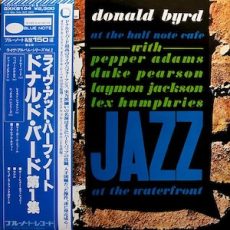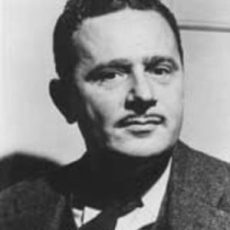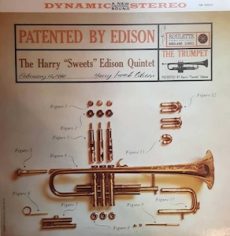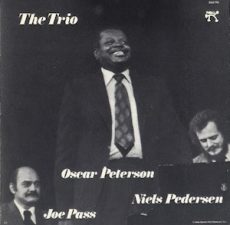
Requisites
Donald Byrd at The Half Note Café, Volume 1 | By Eddie Carter
I was still in the mood to hear another trumpet album after listening to Harry “Sweets” Edison when my search led me to another of my Mom’s favorite records. Donald Byrd and Pepper Adams were two musicians she enjoyed listening to and this morning’s record from the library brings them together in a great live date. Donald Byrd at The Half Note Café, Volume 1 (Blue Note BLP 4060/BST 84060) captures the trumpeter’s quintet featuring Pepper Adams (tracks: A1, A2, B2, B3) on baritone sax, Duke Pearson on piano, Laymon Jackson on bass and Lex Humphries on drums in performance at one of New York’s best jazz clubs. This album holds a special place in my heart because it reminds me of the music my Mom and I used to enjoy together during Sunday dinner. My copy is the 1978 King Record Company Japanese Stereo reissue (Blue Note BST 84060 – GXK-8104).
Ruth Mason is our Mistress of Ceremonies for the evening and starts the set with the musician’s introductions. The quintet then launches into the upbeat melody of My Girl Shirl by Duke Pearson. Donald kicks off the solos with an invigorating statement; then Pepper succeeds him with a joyfully spirited solo. Duke emerges next for a brisk presentation, and the front line cooks with Lex ahead of the close. Donald introduces the next tune, his own Soulful Kiddy, a blues that slows the beat down for the ensemble’s marching melody. Pepper serves up some down-home cooking in the opening solo. Donald comes into the second reading with carefree enthusiasm; then Duke eases into the spotlight last, leading to the theme’s restatement and climax.
Side Two opens with Donald’s introduction to A Portrait of Jennie by J. Russel Robinson and Gordon Burdge. The quartet showcase begins with the trumpeter’s romantically warm introduction to the melody. He continues mining a rich vein of sentimentality in the first solo. Duke takes over to deliver a very pretty reading until Donald’s return to add a few more comments into the reprise and close. Cecile by Donald Byrd brings the quintet back for a medium blues that commences with the trio’s introduction to the front line, taking the lead in the melody. Pepper takes off first, cruising at a comfortable pace. Donald gets to work next with an impressive interpretation, and then Duke completes the infectious beat in the finale ahead of the quintet’s closing moments.
The set climaxes with the group’s theme, Pure D. Funk. Donald has the showcase to himself in a concise theme and the song’s only solo into the ensemble’s conclusion. Alfred Lion produced Donald Byrd at The Half Note Café, Volume 1, and Rudy Van Gelder was behind the dials. The reissue has an excellent soundstage transporting the listener to the club audience with excellent fidelity. The unique sound of this album, with its stellar rhythm section and the great chemistry between Donald Byrd and Pepper Adams, is sure to captivate any jazz enthusiast. I invite you to pick up Donald Byrd at The Half Note Café, Volume 1, on your next record shopping trip. It’s a delightful live album that is sure to enjoy repeated plays on the turntable!
Postscript: For those who are unaware, Ruth Mason was a singer and WOV on-air personality who would become Mrs. Alfred Lion. She is also the lovely young woman who appears on the cover of Moods by The Three Sounds.
~ Moods (Blue Note BLP 4044/BST 84044) – Source: Discogs.com © 2024 by Edward Thomas CarterMore Posts: choice,classic,collectible,collector,history,instrumental,jazz,music,trumpet

Jazz Poems
STRANGE FRUIT
Southern trees bear a strange fruitBlood on the leaves and blood at the root
Black body swinging in the Southern breeze
Strange fruit hanging from the poplar trees
Pastoral scene of the gallant South
The bulging eyes and the twisted mouth
Scent of magnolia sweet and fresh
And the sudden smell of burning flesh
Here is a fruit for the crows to pluck,
For the rain to gather, for the wind to suck
For the sun to rot, for a tree to drop,
Here is a strange and bitter crop.
LEWIS ALLANfrom Jazz Poems ~ Selected and Edited by Kevin Young
More Posts: book,classic,collectible,history,jazz,library,poet

Requisites
Patented By Edison ~ The Harry “Sweets” Edison Quintet | By Eddie Carter
Harry “Sweets” Edison was one of the most sought-after musicians in jazz. This morning’s album from the library is a little-known 1960 release titled Patented By Edison (Roulette R-52041/SR-52041) by The Harry “Sweets” Edison Quintet. He was one of the most talented trumpeters of the Swing and hard bop eras, performing with some of the great jazz orchestras. “Sweets” got his nickname from Lester Young and eventually settled on the West Coast to become a successful arranger, composer and musician. On his eleventh date, he assembled a stellar group: Jimmy Forrest (tracks: A1 to A3, A6, B5, B6) on tenor sax, Tommy Flanagan on piano, Tommy Potter on bass, and Elvin Jones on drums. My copy is the 1967 U.S. Stereo reissue.
The album opens with Witchcraft by Cy Coleman and Carolyn Leigh. The rhythm section introduces the tune before the ensemble starts the easy-flowing melody. “Sweets” is on muted trumpet and glides through the song’s only solo with meticulous execution ahead of the reprise and soft ending. Blues Skies by Irving Berlin begins with Jimmy’s brief introduction, setting the tone for the leader taking charge of the beautifully articulated muted theme and a fine solo spot ahead of the saxophonist leading the ensemble out. Confessin’ That I Love You by Doc Daugherty, Ellis Reynolds and Al Nieburg begins with a pleasant presentation by the quintet. “Sweets” shows off his sentimental side in a performance of innocence and loveliness before the close.
Ain’t Misbehavin’ by Harry Brooks, “Fats” Waller, and Andy Razaf was introduced in the 1929 all-black musical revue Hot Chocolates. It became a huge hit among musicians and vocalists. It is a quartet showcase for “Sweets” doing the honors using the mute for the song’s opening chorus and a delightful solo that concludes softly. The first of three creations from Edison’s pen is up next. Candied Sweets is the album’s second quartet presentation beginning with Flanagan’s introduction. “Sweets” unfolds an attractive muted melody anchored by the trio’s gentle groundwork into his opening statement. The pianist complements the leader in a short, relaxing interpretation, leading to his return for the theme’s restatement and a slow dissolve.
The first side closes with They Can’t Take That Away From Me by George, and Ira Gershwin opens with the mute removed for “Sweets” to lead the quintet through the theme. “Sweets” ignites the first solo with an impeccable display of his playing. Flanagan follows him with a short, sparkling statement leading back to the closing chorus and climax. Side Two starts with the mute back on for the album’s third quartet performance, Tea For Two by Vincent Youmans and Irving Caesar. A catchy tune, with the foursome laying down a gorgeous mid-tempo beat for the theme. “Sweets” blends comfortably with the rhythm section’s accompaniment in the song’s only spotlight displaying a marvelous tone into the theme’s reprise and fadeout.
Up next is There Is No Greater Love by Isham Jones and Marty Symes. This gorgeous standard receives a gorgeous treatment beginning with Flanagan’s introduction to a thoughtfully tender melody by “Sweets.” The leader continues with a soft touch of elegance in the first interpretation. Flanagan also adds a dreamlike softness in a short solo preceding the theme’s restatement and climax. Harry Edison’s Twenty–Forty picks up the pace in a swinging quartet showcase. “Sweets” gets things off to a good start during the muted melody and then makes quick work in the opening statement. Potter gets his first opportunity to solo, and he moves sprightly along off the drive of the rhythm section into the ending theme and close.
It’s Easy To Remember (So Hart To Forget) comes from the pen of Richard Rodgers and Lorenz Hart. The rhythm section’s gentle introduction sets the mood for “Sweets,” who handles the muted melody and song’s only solo with so much emotion and sensitivity that it’ll bring tears to your eyes. We’re invited to join the quintet for some Sweetcakes by Harry Edison next. Jimmy is featured in the opening and closing choruses but does not solo. The melody begins with a bluesy beat that might get some fingers popping and toes tapping along. “Sweets” starts the solos with a delightful interpretation that flows with smooth efficiency. Flanagan comes in next to make a concise comment, which wraps everything up nicely ahead of the reprise of the theme.
The album’s final track is Angel Eyes by Matt Dennis and Earl K. Brent. Jimmy introduces the standard alongside the rhythm section before “Sweets” removes the mute to deliver the intimately personal melody. He has the showcase to himself in a beautiful and deeply moving statement that’s romantic and touching into a gorgeous ending. Teddy Reig produced Patented By Edison, and the recording engineer is unknown. However, the album’s sound quality is very good, possessing an excellent soundstage that brings the musicians to the sweet spot in your listening room with stunning fidelity. If you’re a fan of the trumpet, Harry “Sweets” Edison, or enjoy the sound of swing, I offer for your consideration and highly recommend Patented By Edison by The Harry “Sweets” Edison Quintet. It’s an underrated, excellent album by one of jazz’s best trumpet players and shouldn’t be missed on your next record hunt!
~ Ain’t Misbehavin’, Angel Eyes, Blue Skies, Confessin’ That I Love You, It’s Easy To Remember (So Hard To Forget), Tea For Two, There Is No Greater Love, They Can’t Take That Away From Me – Source: JazzStandards.com ~ Witchcraft – Source: Wikipedia.org © 2024 by Edward Thomas CarterMore Posts: choice,classic,collectible,collector,history,instrumental,jazz,music,trumpet

Requisites
The Trio ~ The Oscar Peterson Trio | By Eddie Carter
This morning’s record from the library is a live album featuring three jazz giants. The Trio (Pablo Records 2310 701) is aptly named because it captures Oscar Peterson on piano, Joe Pass on guitar, and Niels-Henning Ørsted Pedersen on bass in performance during three nights at the Chicago jazz club, London House. What makes this album unique is the exceptional chemistry between each musician. Oscar Peterson’s virtuosic piano playing, Joe Pass’s innovative guitar techniques, and Niels-Henning Ørsted Pedersen’s melodic bass lines all shine through in this album. My copy is the 1973 U.S. Stereo release.
Side One starts with the first of two tunes by Oscar Peterson. Blues Etude begins at a brisk clip, with Joe and Niels-Henning firing on all cylinders before Oscar joins them for the melody. Oscar reveals his broad range in the song’s only solo, enhanced by Joe and Niels-Henning’s accompaniment. Chicago Blues is a delicious dish of soul food beginning with a lengthy piano introduction ahead of the trio’s slow-paced melody. Oscar opens with a tasty invitation for everyone to come to the table. Joe takes charge with a delicious second course next. Oscar adds another scrumptious dish to the meal, and then Niels-Henning provides the final course with a succulent solo preceding a luscious ending.
Side Two opens with Easy Listening Blues by Nadine Robinson. The trio gets things started with a polite melody. Oscar begins the song’s only solo with a warm caress of the keys, creating a beautiful musical landscape. Meanwhile, Joe and Niels-Henning tail him closely until the theme’s restatement and conclusion. Come Sunday is a beautiful jazz standard by Duke Ellington that becomes the sole showcase of Joe Pass. The guitarist approaches the theme and song’s only solo with a simple directness, resulting in a wonderful expression of incredible beauty culminating with a tender ending and appreciative applause from the audience.
Secret Love by Sammy Fain and Paul Francis Webster is a lively tune that will have you tapping your toes from the trio’s opening ensemble. Oscar is up first with a happy groove that makes a lasting impression on the listener. Joe steps up next and gives a splendid statement; then Oscar adds a few final comments ahead of the theme’s reprise and the audience’s approval. Norman Granz produced The Trio, and it’s unknown who supervised the live recording. However, the album’s sound quality is excellent with a soundstage that transports the listener to the London House audience as the trio is performing.
If you’re discovering the music of Oscar Peterson and are in the mood for a live album where you become part of the live audience at the London House. I invite you to check out The Trio by The Oscar Peterson Trio the next time you visit your favorite record store. It’s a fantastic album that captures three of the most renowned musicians at the top of their game. The Trio is a title highly recommended for a spot in your library, as it not only showcases the individual brilliance of each musician but also their exceptional chemistry, making it a must-have for any jazz enthusiast!
~ Come Sunday – Source: JazzStandards.com
~ Secret Love – Source: Wikipedia.org
© 2024 by Edward Thomas Carter
More Posts: bass,choice,classic,collectible,collector,guitar,history,instrumental,jazz,music,piano

Jazz Poems
JELLY WROTE
jelly wrote,
you should be walking on four legs
but now you’re walking on two,
you know you come directly from the
animal famulee
& you do. but dr jive
the winding boy, whose hands only work
was music & pushing
“certain ignorant light skin women” to the corner
was never animal
was never beast in storeyville, refining
a touch for ivory on pool green
with the finest of whorehouse ragtime; use even
for the “darker niggers music. rough,” jelly wrote
“but they loved it in the tenderloin.”
o the tall & chancey, the ladies’
fancy, the finest boy for miles around,
“your salty dog,” but with diamond incisors,
shooting the agate under a stetson sky
his st louis flats winked into
aaah, mr jelly
A.B. Spellman
from Jazz Poems ~ Selected and Edited by Kevin Young
More Posts: book,classic,collectible,history,jazz,library,poet



